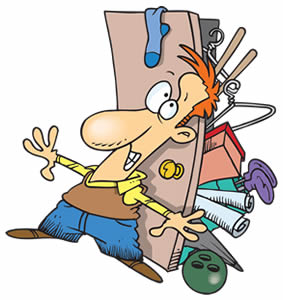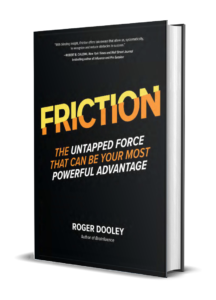 My office closet looked a lot like those overstuffed cartoon closets where the character opens the door and is showered with tennis rackets, golf clubs, winter coats, etc. (For me, the offending contents were electronics, books, files, and other office debris.) So,to get organized, I bought some shelving components at my local big box home store.
My office closet looked a lot like those overstuffed cartoon closets where the character opens the door and is showered with tennis rackets, golf clubs, winter coats, etc. (For me, the offending contents were electronics, books, files, and other office debris.) So,to get organized, I bought some shelving components at my local big box home store.
Installation was easy enough. I located the wall studs, attached the standards, and began installing the brackets. Then, I realized that each item had a label that identified it and had the bar code for price scanning. So, I began the dreaded peeling effort to remove the labels. Past label experiences often resulted in paper and glue residue that required industrial-strength solvents to remove.
I was pleasantly surprised that the adhesive wasn’t too aggressive. The first label I began to remove was a long one, and I got most of it separated cleanly. Just as I was celebrating the easy removal process, the label came apart. The area near the bar code was perforated in a way that shredded that part of the label. The remaining bits had to be scraped off with a fingernail.
Every single component had a label like this. It probably took 20-30 seconds of effort to remove each one completely. That’s not a huge problem, but it was increasingly annoying as I worked through the pile of components. Label removal took ten times as long as the far easier process of installing the brackets and shelves.
Even small amounts of effort become annoying when repeated multiple times. #CX #FrictionHunter Share on X
We’re Customer-Centric. Really.
I was momentarily perplexed by the disintegrating labels. Then, I realized they were made this way to prevent label switching in the store. An unscrupulous customer could remove a label from a $2 item and put it on a $20 item, costing the retailer $18.
Surely, you say, any moderately intelligent cashier would catch obvious label switching. Perhaps. But, not if the retailer is aggressively pushing customers to self-checkout by having few human cashier lanes available. While self-checkout can be an annoyance to honest customers, it’s a magnet for dishonest ones. (A self-checkout option is great, but “forced” self-checkouts are yet another way businesses add friction to their customer experience to serve their own goals.)
Ironically enough, the shelving manufacturer’s “about us” page notes, “It’s all about you!” I was wondering how this self-proclaimed customer focus squared with the shredding labels when I realized that I wasn’t the customer. The big-box retailer was their customer. And, if the store wanted to push customers into self-checkout lanes without losses from label-switchers, the manufacturer would accommodate them with shredding labels.
The retailer also proclaims they “put customers and associates first.” Most of the time, perhaps.
Trust and Friction
 Friction is often caused by a lack of trust. We have banks and vaults because we don’t trust others not to steal our valuables. We have passwords and other security features on websites because we don’t trust other people not to impersonate us.
Friction is often caused by a lack of trust. We have banks and vaults because we don’t trust others not to steal our valuables. We have passwords and other security features on websites because we don’t trust other people not to impersonate us.
As I describe in FRICTION, though, sometimes an unwarranted lack of trust can cause unnecessary and wasted effort. I tell a story from Jack Welch’s tenure at GE about how by trusting a worker not to steal work gloves they eliminated a time-consuming requisition process that wasted hours every month. Another business owner decided to trust employees and got rid of both time cards and a central tool crib. Both of these processes had made workers waste time by standing in line to record their time or get needed tools.
Not only did these trust-based interventions save time, they also built employee trust in the company. Trust is reciprocated.
Did a few people abuse this trust by stealing the odd pair of work gloves or fudging their time reporting? Probably. But the overall result was positive in both financial terms and employee engagement. The company trusted their employees, and also trusted that their managers would spot egregious abuse.
Perception of Effort
My customer experience wasn’t diminished that much by scraping off the sticky paper shreds. But, just as Amazon pioneered frustration-free packaging to eliminate the inconvenience of opening plastic clamshells, could this brand have found a better solution? Did they even consider the effort of the consumer at home, or did they focus only on the needs of their direct customer, the retailer? And, for the store, are the projected losses from a few label-switchers enough to justify the wasted effort by millions of honest customers?
Decisions like this shouldn’t be based on “best practices” or made by one individual or department. Advocates for customer experience need a seat at the table. Ask, “What would Jeff Bezos do?” when faced with balancing CX against other issues.
Ask 'What would Jeff Bezos do?' when you have to balance #CustomerExperience against demands from departments like Compliance, IT, and Security. #FrictionHunter Share on X
The #FrictionHunter lesson is that even small amounts of effort become annoying when they are repeated. Getting the label detritus off of a single product wouldn’t have been a problem. I probably wouldn’t have noticed. But, repeating the process again and again increased my level of perceived friction. And, we know, it’s the perception of effort that counts and it’s your customer’s perception that counts.
 Join the fight against unnecessary friction! When you encounter an annoying or time-wasting user experience, post about it with the hashtag #FrictionHunter. Or, send me an email: friction at rogerdooley dot com.”
Join the fight against unnecessary friction! When you encounter an annoying or time-wasting user experience, post about it with the hashtag #FrictionHunter. Or, send me an email: friction at rogerdooley dot com.”